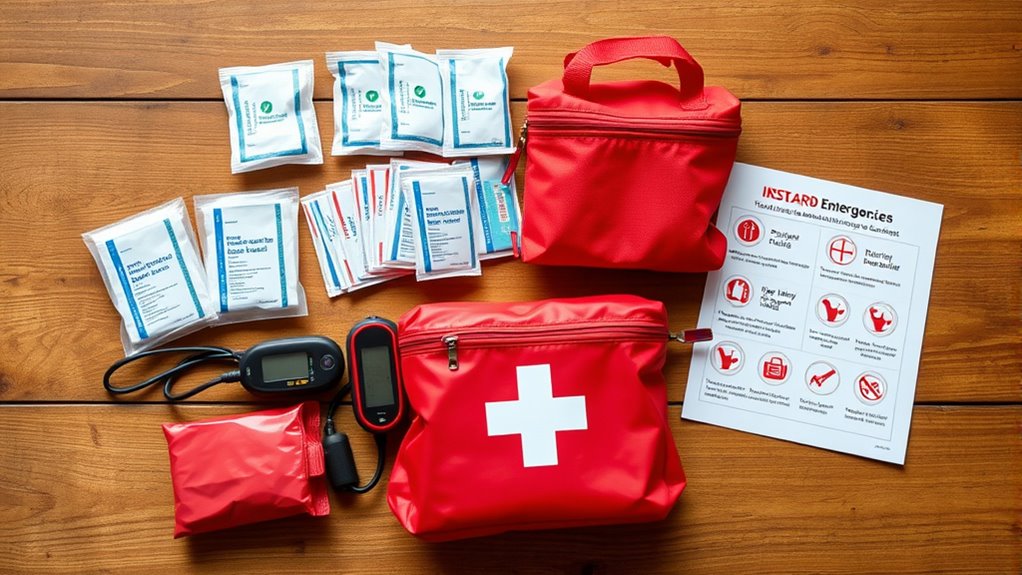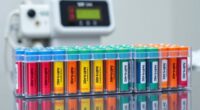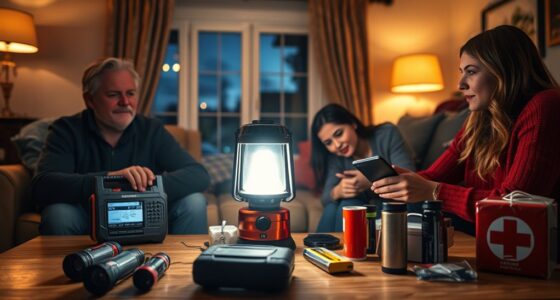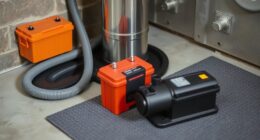To stop guessing when storms hit, focus on scene safety first and assess the situation carefully. Gather essential supplies like bandages, antiseptic wipes, and gloves to handle injuries promptly. Know how to manage cuts, burns, and sprains, and recognize signs of shock, hypothermia, or frostbite. Always seek professional help for severe conditions. Keep these basics in mind, and you’ll be prepared to respond confidently when storms strike—more helpful tips await you.
Key Takeaways
- Ensure scene safety and assess for hazards before providing first aid.
- Use proper supplies like bandages, antiseptics, gloves, and flashlights for storm-related injuries.
- Manage cuts, burns, and sprains promptly with cleaning, cooling, and immobilization techniques.
- Recognize signs of shock, hypothermia, or waterborne illnesses and respond appropriately.
- Seek emergency help immediately for severe injuries, head trauma, or worsening conditions.
Assessing the Situation Safely
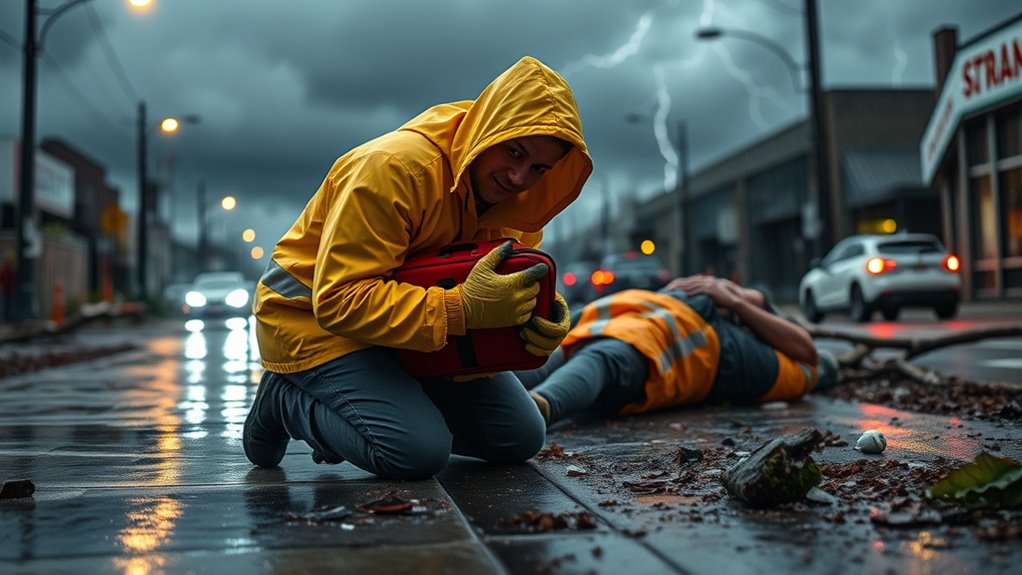
Before approaching a storm-affected scene, you must guarantee your safety first. Conducting a thorough risk evaluation helps you identify potential dangers like fallen power lines, unstable structures, or flooding. Always prioritize scene safety before offering aid. Look for hazards that could harm you or others, and determine if it’s safe to proceed. If the scene appears unsafe, wait for professionals or help others to secure the area. Avoid rushing in blindly, as you could become another victim. Use your judgment to evaluate the environment carefully. Remember, your safety is essential for effective assistance. By assessing the scene properly, you reduce the risk of injury and ensure that you can provide first aid effectively when it’s safe to do so. Recognizing hazardous conditions, such as downed electrical wires or unstable debris, is crucial in preventing further injuries.
Essential First Aid Supplies for Storms

Having the right first aid supplies on hand is vital for effectively responding to storm-related injuries. A well-stocked kit ensures you can address common issues quickly, especially during storm shelter safety emergencies when professional help may be delayed. Include essentials like bandages, antiseptic wipes, scissors, and gloves to treat cuts and wounds. A flashlight and extra batteries are indispensable for visibility if the power goes out, while a whistle can help with emergency communication to signal for help. Don’t forget a list of emergency contacts and a first aid manual for quick reference. Keeping these supplies organized and accessible minimizes chaos during stressful times, allowing you to respond promptly and confidently, ensuring safety for everyone involved. Properly organizing your supplies ensures quick access when seconds count.
Managing Cuts and Scrapes During Storms
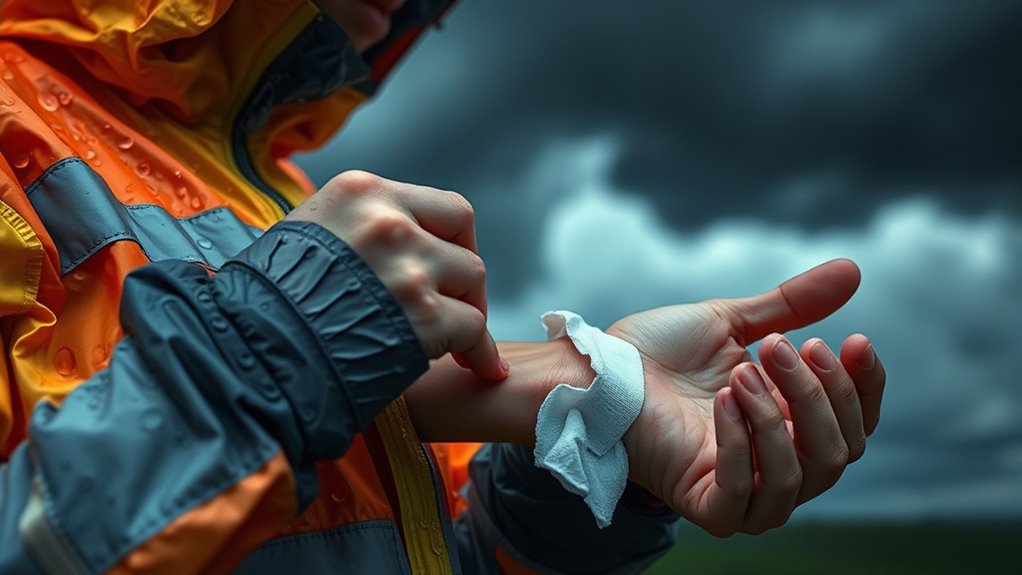
When managing cuts and scrapes during storms, it’s essential to clean the wound thoroughly to prevent infection. Make sure to use clean water and gentle soap, then pat the area dry. After cleaning, apply a proper bandage to protect the wound and keep dirt out.
Cleaning the Wound
During storms, cleaning a wound promptly is essential to prevent infection and promote healing. Start by washing your hands thoroughly to avoid introducing bacteria. Gently rinse the cut or scrape with clean water to remove dirt and debris. Use antiseptic application to disinfect the area, reducing the risk of infection. Remember, proper wound cleaning involves careful but gentle handling. Additionally, using appropriate lighting and visibility can help ensure you thoroughly clean the area and avoid missing any dirt or debris that could cause infection. You can make this easier by:
- Using clean, running water for rinsing
- Avoiding harsh chemicals that can irritate the skin
- Patting the wound dry with a clean cloth or sterile gauze
- Applying antiseptic lightly to disinfect the area
Taking these steps ensures your wound is clean and ready for further treatment, helping it heal faster during storms.
Applying Bandages Properly
After cleaning a wound, applying a proper bandage helps protect it from dirt, bacteria, and further injury. Use correct bandage techniques to guarantee the wound dressing stays secure and effective. Start by covering the wound with a sterile gauze pad or non-stick dressing, then wrap the bandage firmly but not too tight to avoid cutting off circulation. Make sure the edges of the bandage overlap slightly and cover all exposed skin. Secure the bandage with tape or clips, ensuring it stays in place during movement. Check regularly for signs of swelling or discomfort, adjusting the dressing as needed. Proper bandage application minimizes infection risk and supports healing, especially during storms when access to medical help may be delayed. Additionally, understanding proper wound care techniques can help prevent complications and promote faster recovery.
Handling Head Injuries and Concussions
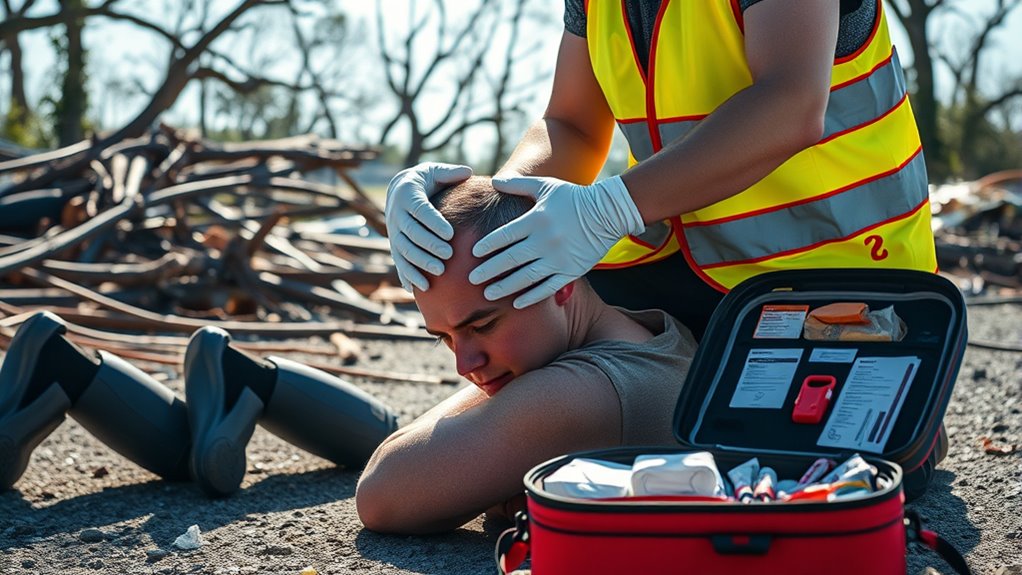
Head injuries and concussions require prompt and careful response to prevent further harm. Your first step is to perform a head injury assessment by checking for signs like dizziness, confusion, or loss of consciousness. Watch for concussion symptoms such as headache, nausea, blurred vision, or sensitivity to light. Keep the injured person still and avoid moving their head unnecessarily. If available, using an air purifier can help reduce airborne irritants and create a cleaner environment that may support faster recovery. Remember: – Stay calm and reassure them – Call emergency services if they lose consciousness or exhibit severe symptoms – Keep them awake and alert if possible – Avoid giving them food or drink until fully evaluated Your goal is to monitor their condition while preventing additional injury. Acting quickly and thoughtfully can make a big difference in their recovery.
Responding to Broken Bones and Sprains

When you encounter someone with a broken bone or sprain, your first step is to immobilize the injury to prevent further damage. You should also manage their pain by applying ice and keeping them comfortable. Properly handling these injuries helps guarantee a quicker recovery and reduces complications. Additionally, avoiding common issues like improper splinting or movement can significantly improve healing outcomes.
Immobilize the Injury
To effectively respond to broken bones and sprains during a storm, you need to immobilize the injury as quickly as possible. Proper injury stabilization prevents further damage and reduces pain. Start by supporting the injured limb without moving it unnecessarily. Use a splint application if available, ensuring it extends beyond the joints above and below the injury. Keep the limb in the position you find it to avoid causing more pain. Secure the splint firmly but not too tight, to prevent circulation issues. Remember, immobilization is key for safe transport and recovery. Additionally, if you are familiar with Honda Tuning, understanding how vehicle modifications can influence handling may help in emergency scenarios involving vehicle accidents.
Manage Pain Effectively
Managing pain effectively during a storm involves taking immediate steps to reduce discomfort and prevent shock. Start with proper medication management—if you have access to pain relievers, administer them carefully following dosage instructions. Use pain relief techniques like applying ice packs to the injured area to numb nerves and reduce swelling. Elevate the limb if possible to minimize blood flow and alleviate pain. Keep the person calm and still, avoiding unnecessary movement, which can worsen injuries. Comfort measures such as keeping them warm and reassured help prevent shock. Additionally, be mindful of the signs of spoilage in any exposed or stored first aid supplies to ensure they are safe to use. Remember, controlling pain isn’t just about comfort; it’s essential for stabilizing the injury and supporting recovery. Always prioritize safety and seek professional help as soon as possible.
Treating Burns Caused by Storm-Related Hazards

Storm-related hazards like downed power lines, hot surfaces, and fireworks can cause serious burns. These include thermal burns from heat sources and chemical burns from hazardous substances. To treat burns effectively:
- Remove yourself from the source immediately.
- Cool the burn with running water for at least 10 minutes.
- Cover the burn with a sterile, non-stick bandage.
- Avoid applying ointments or breaking blisters.
- Creating a digital-friendly environment at home can help educate children about online safety and responsible digital use.
For thermal burns, quick cooling reduces tissue damage. Chemical burns require thorough rinsing to wash away harmful substances. Do not use ice or greasy substances, as they can worsen the injury. If the burn is large, deep, or involves the face or genitals, seek urgent medical help. Proper first aid minimizes damage and promotes healing.
Recognizing and Addressing Shock
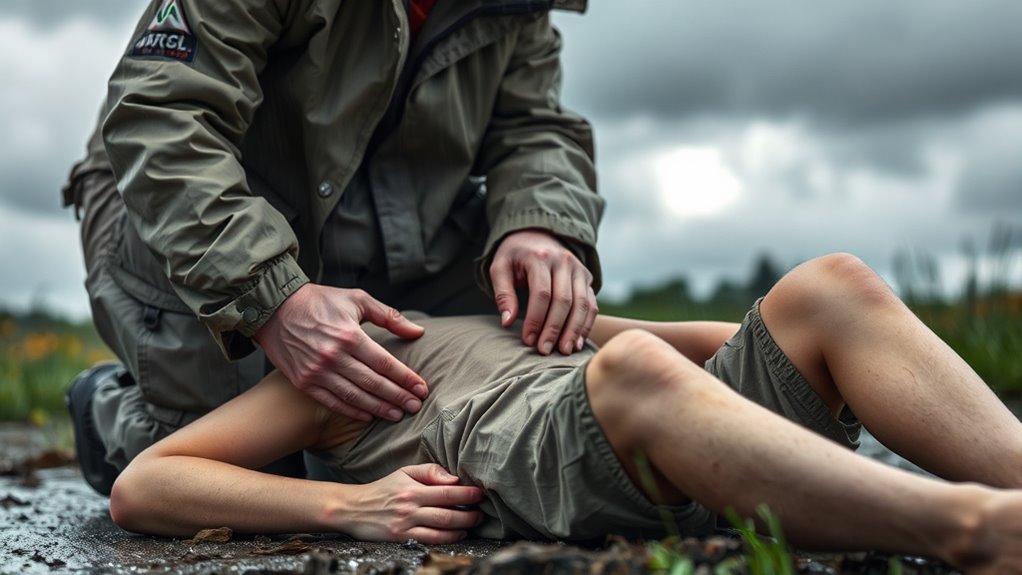
Shock can occur when your body doesn’t get enough blood flow, often as a result of severe injuries or blood loss during storms. Recognizing shock signs early is vital. Look for pale, clammy skin, rapid heartbeat, weak pulse, and shallow breathing. The person may also be confused or drowsy. To check circulation, feel their pulse at the wrist or neck; if it’s weak or rapid, it indicates poor circulation. You should also assess skin color and temperature. If you suspect shock, keep the person lying flat, elevate their legs if possible, and cover them with a blanket to maintain body heat. Call emergency services immediately. Acting quickly to recognize and address shock can save a life during storm emergencies.
Dealing With Hypothermia and Frostbite Risks

You need to act quickly if you notice someone shivering, confusion, or numbness, as these are signs of hypothermia or frostbite. Once identified, move the person to a warmer area and remove any wet clothing. Providing gentle, warm blankets and avoiding direct heat helps stabilize their condition until professional help arrives. Additionally, understanding the importance of temperature regulation can improve how effectively you respond to cold-related injuries.
Recognizing Symptoms Quickly
Recognizing the early signs of hypothermia and frostbite is essential for preventing serious health complications during storms. Early detection allows you to act promptly and seek medical help if needed. Keep an eye out for these symptoms:
- Shivering that won’t stop
- Cold, pale, or waxy skin
- Numbness or tingling, especially in fingers and toes
- Confusion or difficulty speaking
Immediate Care Steps
When someone shows signs of hypothermia or frostbite, acting quickly can prevent serious damage. Your first step is to move them to a warm, sheltered area and remove wet clothing. Avoid rubbing affected areas, as this can worsen injuries. Use blankets or warm compresses to raise body temperature gradually. Maintain open emergency communication to alert rescue services if needed. During storm preparedness, keep a kit with extra clothing and thermal blankets. Remember, timely intervention is crucial. To understand the severity, consider this:
| Symptom | Immediate Action | Warning Signs |
|---|---|---|
| Hypothermia | Warm gradually, provide warm drinks | Confusion, shivering, drowsiness |
| Frostbite | Gently rewarm affected areas | Numbness, white or gray skin |
| Emergency Alert | Call rescue if condition worsens | Loss of consciousness, severe pain |
How to Prevent and Treat Waterborne Illnesses
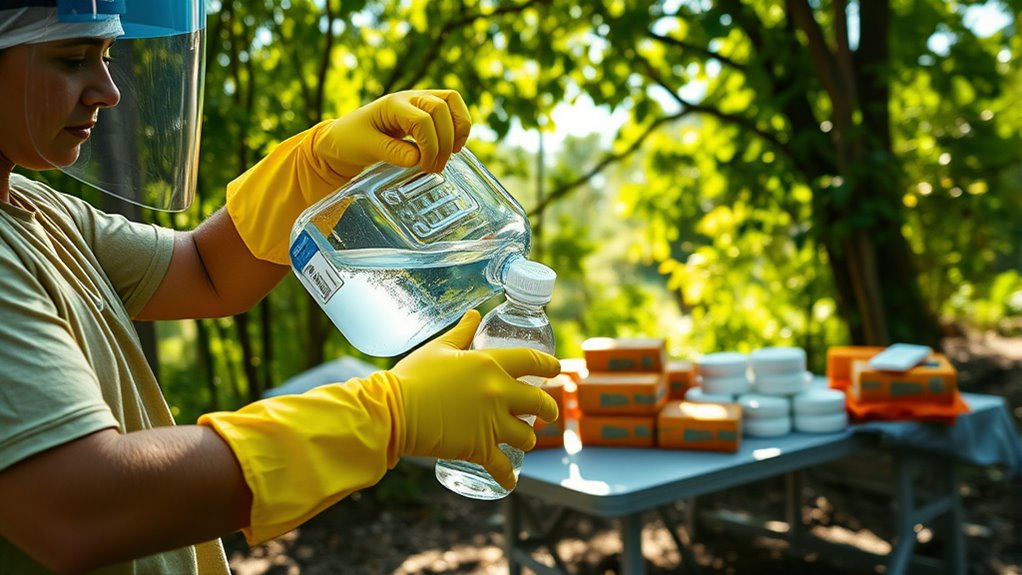
During storms, contaminated water sources can quickly lead to waterborne illnesses if not properly managed. To prevent this, focus on water purification and sanitation practices. You can boil water for at least a minute, use water purification tablets, or employ portable filters to guarantee safety. Keep your environment clean by washing hands often with soap and safe water, and avoid direct contact with floodwaters. Store drinking water in clean, covered containers to prevent contamination. Here are some key tips:
- Boil or filter water before drinking or cooking
- Use sanitation practices like handwashing regularly
- Keep food and water containers sealed
- Avoid using water from questionable sources
Following these steps reduces your risk of illness and keeps you healthier during and after storms.
When to Seek Professional Medical Help
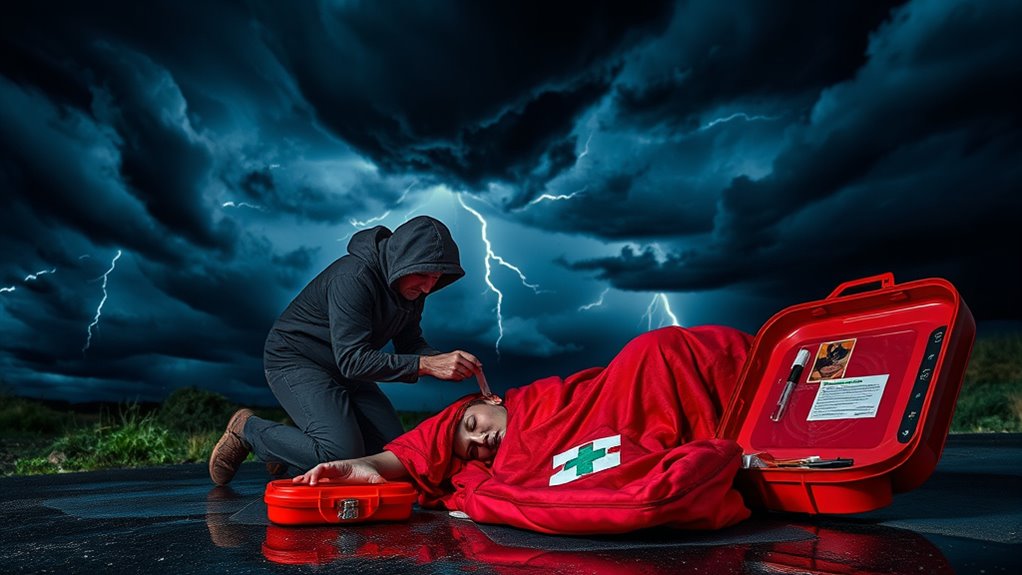
Knowing the signs of serious injury or illness is essential, as prompt professional medical help can prevent complications and save lives. During storms, your storm preparedness should include knowing when to call for emergency communication. If someone shows signs of severe bleeding, chest pain, difficulty breathing, or unconsciousness, don’t hesitate to seek immediate help. Also, watch for signs of shock, severe burns, or head injuries. If a person’s condition worsens or doesn’t improve after initial first aid, professional intervention is necessary. Remember, storm conditions can delay help, so stay connected with emergency services through your phone or radio. Don’t underestimate the importance of timely action—getting professional medical help when needed can make a critical difference in recovery.
Frequently Asked Questions
How Can I Identify Signs of a Serious Head Injury in Storm Conditions?
You can identify signs of a serious head injury by looking for concussion symptoms like dizziness, confusion, or loss of balance. Watch for head injury signs such as bleeding, swelling, or an unusual bump. If someone’s unconscious, complains of severe headache, or has blurred vision, seek emergency help immediately. Remember, in storm conditions, keep them safe from further harm and avoid moving them unless necessary.
What Are the Best Ways to Prevent Hypothermia During Prolonged Storms?
To prevent hypothermia during prolonged storms, you should wear clothing insulation like layered, waterproof, and windproof clothes. Keep your shelter insulation high by adding blankets, sleeping bags, or insulating materials to your shelter’s floor and walls. Stay dry and avoid sweating, which can lower your body temperature. Seek shelter from wind and rain, and keep moving to generate body heat without overexerting yourself.
How Do I Safely Remove Debris Around Someone With a Suspected Fracture?
Make certain scene safety first, then carefully assess the debris around the person with a suspected fracture. Use debris removal techniques like gently lifting or shifting objects away without applying pressure to the injured area. Avoid pushing debris directly on the fracture site, and if necessary, use a sturdy object to create space. Always prioritize your safety and call emergency services immediately for further assistance.
What Are Common Waterborne Illnesses During Storms and Their Symptoms?
During storms, you might encounter waterborne pathogens causing flood-related illnesses. Watch for symptoms like diarrhea, nausea, vomiting, fever, and stomach cramps. These illnesses spread through contaminated water, so staying vigilant is key. To protect yourself, avoid drinking or bathing in floodwaters, and seek medical help if symptoms appear. Staying informed and practicing good hygiene helps minimize your risk of falling ill from these common waterborne threats.
When Should I Prioritize Seeking Emergency Medical Assistance Over First Aid?
You should prioritize seeking emergency medical assistance when the injury or illness is severe, such as heavy bleeding, difficulty breathing, signs of shock, or unconsciousness. In emergency response situations, your medical priorities shift to stabilizing the person quickly and calling for professional help. Don’t delay if symptoms worsen or if the situation surpasses basic first aid capabilities, as prompt medical attention can prevent complications or death.
Conclusion
Now you’re prepared to handle storm-related injuries confidently, just like a seasoned sailor steering rough seas. Keep your first aid kit handy, stay calm, and remember these tips—because in stormy weather, every second counts. Don’t forget, even the bravest explorers need to know when to call for professional help. Stay safe, stay smart, and don’t let the storm catch you off guard—think of it as your own personal “hocus pocus” for staying prepared!
